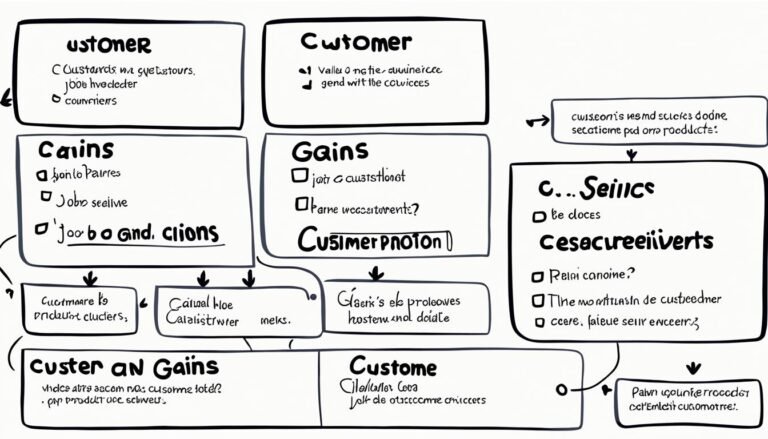Unlocking Efficiency with Michael Porter’s Value Chain
Have you ever thought about why some companies do better than others? Maybe the answer is in how they run their business inside. Michael Porter’s Value Chain shows us how different business tasks work together to make value. This article will dive into the value chain model. It will show how it helps companies stand out in today’s fast market.
Key Takeaways
- The Value Chain Model breaks down business tasks into main and support activities for better efficiency.
- Now, sustainable sourcing is key, showing the importance of ethical practices in supply chains.
- Cost changes in things like food affect profits.
- Using automation and digital tools can make businesses run smoother.
- How companies talk to clients and serve them after a sale sets them apart.
- Putting money into research and development is key for new ideas and green products.
Introduction to the Value Chain Model
The Porter’s value chain model is key in today’s business world. Companies compete hard in a global market. They look for ways to work better. The value chain framework helps by focusing on important tasks that lead to success.
Michael Porter talked about this idea in his book, Competitive Advantage, back in 1985. He showed how both main and support activities matter. Main activities like getting materials, making products, selling, and after-sales service create direct value. Support activities, like buying materials, developing technology, managing people, and building infrastructure, make these main activities better.
Looking closely at the value chain helps companies see where they can save money or make unique products. For example, Trader Joe’s uses its own brand for most products, making big profits by buying materials cheaply. Using new technologies is crucial in this process, especially as businesses change with the fourth industrial revolution.
Understanding Michael Porter’s Value Chain
Michael Porter’s Value Chain is a key tool for companies to find their edge in the market. It breaks down activities into primary and secondary types. This helps companies see how each part adds value. By focusing on these areas, businesses can get better at what they do.
Overview of Porter’s Value Chain Model
In his 1985 book *Competitive Advantage: Creating and Sustaining Superior Performance*, Porter introduced the value chain. It includes five main activities: getting materials, making the product, shipping it, selling it, and providing services. Each activity is key to meeting customer needs and making money.
There are also four support activities: getting supplies, managing people, developing technology, and building infrastructure. These help keep the main activities running smoothly. Together, they form a strong system aimed at making a profit.
Importance of Value Chain Analysis
Value chain analysis has big benefits for companies wanting to do better and make more money. It helps create a clear picture of what’s important, making things more efficient. By looking closely at each step, companies can find ways to improve.
This approach shows how important it is to add value to stay ahead. It might not cover everything, like Finance, but it focuses on what’s inside the company. Companies that use this method well often do better in their markets.
The Components of the Value Chain Framework
Understanding the Value Chain Framework is key for companies wanting to get ahead. Michael Porter’s framework splits activities into two main parts: primary and support. Each plays a big role in making value and keeping operations running smoothly.
Primary Activities: Key Value Creators
Primary activities are crucial for making value in an organization. They cover:
- Inbound Logistics: Getting, storing, and managing inventory.
- Operations: Turning inputs into the final product.
- Outbound Logistics: Getting products to customers.
- Marketing and Sales: Pulling in customers and boosting sales.
- Service: Adding value and making customers happy.
These primary activities are key to a company’s strategy and profits. Amazon is a great example of how to do this well. They make sure their value chain activities work together to give customers a great experience and keep operations efficient.
Support Activities: The Backbone of Operations
Support activities help primary activities run well. They include:
- Procurement: Getting the goods and services needed for making things.
- Technology Development: Using new tech to better processes and products.
- Human Resource Management: Hiring, training, and boosting employee performance.
- Infrastructure: The systems and structures that support daily work.
Support activities boost an organization’s ability by giving it the resources and tech it needs. For instance, Apple, Inc. uses its support functions to handle vendor relationships and streamline its supply chain.
Implementing Value Chain Activities for Competitive Advantage
Organizations want to stand out by improving their value chain. This starts with making inbound and outbound logistics better. By getting resources and products to customers faster and cheaper, companies can meet needs and cut costs.
Optimizing Inbound and Outbound Logistics
Inbound logistics is about getting materials, storing them, and managing inventory. Walmart is great at this by using smart inventory systems. This keeps costs down and makes operations smooth. Such efficiency boosts profits and strengthens market position.
Outbound logistics is about getting products to customers. Amazon leads here with advanced tech and shipping methods. Quick delivery makes customers happy and loyal. Being good at these logistics steps is key to a strong value chain strategy.
The Role of Marketing and Sales in Value Creation
After logistics are improved, focus on marketing and sales. These are crucial for connecting products with people and making money. A strong marketing plan can make brands known and increase demand. Using digital marketing and engaging with customers can lead to more sales.
Big brands use targeted marketing to reach specific groups and stand out. Adding marketing to the value chain boosts market presence and value creation. Focusing on marketing can help companies grow and stay ahead in the market.
| Activity | Focus Area | Competitive Advantage |
|---|---|---|
| Inbound Logistics | Efficiency in procurement and inventory management | Cost Leadership |
| Outbound Logistics | Optimization of delivery systems | Quality Service |
| Marketing & Sales | Brand promotion and customer relationship management | Differentiation |
| Service | Post-sale support and customer service | Customer Loyalty |
Value Chain Management for Efficiency
Value chain management is key to making operations better and staying ahead in the market. It focuses on making both main and support activities more efficient. This helps cut down on waste and ensures high-quality products.
Strategies for Effective Operations Management
For the best use of value chain management, it’s vital to have strong operational strategies. These strategies include:
- Minimizing Waste: Using lean methods to cut out extra steps makes the process smoother and cheaper.
- Enhancing Productivity: Automation and smart scheduling boost output without losing quality.
- Ensuring Quality: Regular quality checks make customers happy and keep them coming back.
Human Resource Management as a Support Activity
Human resource management is a key part of the value chain. It makes sure the team has the right skills to carry out operations well. The perks of good human resource management are:
- Developing Skills: Training and developing employees leads to a team ready for ongoing improvement.
- Fostering a Performance Culture: A culture of accountability links employee goals with the company’s aims for better results.
- Enhancing Employee Retention: Happy employees stay longer, bringing their skills and experience to the company’s long-term success.
Industry Applications of Porter’s Value Chain
Porter’s Value Chain is widely used in many industries. Companies use it to make their supply chains better, manage logistics well, and follow the law. This section looks at how it helps companies stand out in the market.
Case Study: Value Chain in the Oil and Gas Sector
In the oil and gas industry, analyzing the value chain is key to making things run smoothly and efficiently. Companies here use strategies like:
- Optimizing inbound logistics by building strong supplier relationships.
- Using new technologies for operations to get better at extracting and processing.
- Having good outbound logistics to deliver products on time.
- Using smart marketing and sales to reach more people.
- Providing top-notch after-sales service to make customers happy.
By looking closely at their value chain, companies can spot areas to improve, cut costs, and get ahead in the market.
Insights from ITC Limited: A Diverse Approach to Value Creation
ITC Limited uses the value chain well across its different areas. It gets ahead by:
- Buying materials in a way that is good for the planet.
- Investing in technology development to make production better.
- Using smart marketing to connect with different customers.
- Putting a lot of effort into training its workers.
This wide-ranging strategy helps create value and stay strong over time. ITC Limited shows how linking business steps with the value chain is key to beating the competition.
| Sector | Value Chain Activities | Competitive Advantage |
|---|---|---|
| Oil and Gas | Supply chain optimization, logistics management | Cost reduction, operational efficiency |
| ITC Limited | Sustainable sourcing, technology development | Market differentiation, brand loyalty |
Challenges and Solutions in Value Chain Strategy
Organizations face big challenges when they try to put a value chain strategy into action. These challenges include dealing with cost changes in main activities and needing new ideas in support activities. Companies must tackle these problems head-on to keep making profits and stay ahead in the market.
Addressing Cost Variations in Primary Activities
Managing costs well is key in main activities, like in farming and making goods. Changes in raw material prices, labor costs, and not being efficient can really hurt profits. Companies like P&G and Sara Lee show how to handle these ups and downs.
They keep checking and tweaking their main activities. This helps them stay financially strong and keep giving value to customers.
Innovations and Challenges in Support Activities
Support activities need to keep up with fast-changing technology to stay useful. New ideas in areas like buying goods and managing people are key to doing things better. Companies like Shell and Siemens use technology to make their support tasks smoother, which helps them be quick and adaptable.
They also use new roles, like “external scouts” for new ideas and “internal evangelists” to spread new ideas. This makes their support activities stronger and helps them deal with challenges.
Conclusion
Michael Porter’s Value Chain offers a detailed plan for businesses to boost their efficiency and stand out in the market. It breaks down the value chain into different parts, like inbound logistics and marketing, and support activities like tech development and HR. This helps companies find ways to get better and grow.
Knowing how to make these parts work better lets firms create strategies that save money or make their products stand out. For instance, Wellington Brewery shows how managing activities well can make a brand strong and loyal customers. In today’s tech world, being able to add new ideas to the value chain is key for lasting success.
Michael Porter’s Value Chain is a powerful tool for companies aiming for top performance. It gives insights that help companies focus on what really matters. This approach is still important today for staying ahead and bringing new ideas to the market.
Source Links
- Unlocking Business Efficiency: Porter’s Value Chain Analysis for ITC Limited
- Unlocking Efficiency -Application of the value chain model in Energy Supply chain.
- Introduction
- Value Chain: Definition, Model, Analysis, and Example
- The Complete Guide to Value Chains
- What Are the Primary Activities of Michael Porter’s Value Chain?
- Porter’s Value Chain: Your Map to Business Success | Lucidity
- Porter’s Value Chain Analysis explained
- Michael Porter Value Chain Analysis Model: Examples & Applying Steps
- Value Chain Framework
- Value chain: Definition, examples, and guide
- Creating a Competitive Advantage with Value Chain Analysis – Vast Thinking Consults Ltd
- How to Win with Porter’s Value Chain by Creating Competitive Advantage
- The value chain of Porter | Inchainge
- What Is a Value Chain Analysis? 3 Steps | HBS Online
- Drive Success with Porter’s Value Chain Understanding | Wrike
- Porter’s Value Chain
- The Innovation Value Chain
- Unlocking Value Chain Analysis for Strategic Growth
- The Complete Guide to Value Chain Modeling | Smartsheet
- Value Chain Analysis
- Staying one step ahead of the competition with Porter’s Value Chain Analysis







